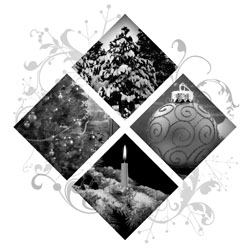Christmas Trees
The following text is drawn from our featured Christmas book and is also available for free as audio.
 Lighted trees were certainly used in various pagan religious celebrations throughout history, but contrary to popular belief, there does not appear to be any direct link between the pagan rituals and the Christmas tree. Rather, the Christmas tree almost certainly has its roots (no pun intended) in Christian practices.
Lighted trees were certainly used in various pagan religious celebrations throughout history, but contrary to popular belief, there does not appear to be any direct link between the pagan rituals and the Christmas tree. Rather, the Christmas tree almost certainly has its roots (no pun intended) in Christian practices.
Among the many accounts claiming to explain the origin of the Christmas tree, the three most popular are from Germany — making it the likeliest place of origin. The stories span from the 8th to the 16th century; all three are rooted in historical fact and may even be connected to one another.
(1) The first story is about St. Boniface (whose birth name was Winfried). In the 8th century, he was a missionary to some of the remotest tribes of Germany. He is probably best known for what is called the “Felling of Thor’s Oak.” It is said that upon entering a town in northern Hesse (hessa), Boniface learned that the people worshiped the god Thor. They believed that Thor resided in a great oak tree among them. Boniface determined that if he wanted to earn an audience with the people, he would have to confront Thor. He announced before the people that he was going to cut down the oak, and he openly challenged Thor to strike him down. Miraculously, as Boniface began to chop the oak, a mighty wind blew and hurled the tree to the ground. Tradition holds that a fir tree was growing in the roots of the oak, and Boniface claimed the tree as a symbol of Christ. Needless to say, the people readily accepted Boniface’s message, and the tree would serve as a reminder of the mighty God who was humbly born into the world as a man on Christmas day.
(2) Another possible source of the Christmas tree comes from medieval religious plays in Germany. Among the most popular of these plays was the “Paradise” play. It started with the creation of man, acted out the first sin, and showed Adam and Eve being expelled from Paradise (the Garden of Eden). It closed with the promise of a coming Savior, which made the play a particular favorite during the Christmas season. In the play, the Garden of Eden was most often represented by a fir tree hung with apples and surrounded by candles.
At one point, religious plays were suppressed in Germany, and the popular symbol of the Paradise play made its way into the homes of Christians. By the 15th century, Christians started to decorate their trees not only with apples (the symbol of sin and the need for a Savior) but with small white wafers (the symbol of Christ’s body, the Savior). These wafers were later replaced by little pieces of pastry cut in the shape of stars, angels, bells, etc.
The connection between the Garden of Eden (Paradise) and Christmas is profound. The first sin in the Garden of Eden was eating from the tree of the knowledge of good and evil, and wanting to be like God. How did God address this sin? God became a man that we might be saved. And trees play a significant role in the entirety of the Christian story, for the temptation that brought sin into the world hung on a tree (the forbidden fruit), and the act that resulted in salvation from sin (Christ on the cross) hung on a tree. Furthermore, once sin entered the world in the Garden of Eden, Adam and Eve, and all mankind, were no longer permitted to eat of the tree of life. However, in eternity, Christ’s work on the cross will give us “the right to eat of the tree of life” once again (Revelation 2:7).
(3) A third tradition about the origin of the Christmas tree attributes it to Martin Luther, the leader of the Reformation. Some say that on Christmas Eve, Luther was walking through the woods near his home. He was struck by the beauty of how the snow shimmered in the moonlight on the branches of the trees. In an effort to re-create the magnificent sight for his family, he cut down the tree, placed it in his home, and decorated it with candles.
Though Christmas trees may have already existed in homes throughout Germany at the time of Luther, it is possible that he did in fact conceive the idea of adding candles to their branches. He may have been erroneously credited with beginning the tradition of the Christmas tree itself simply because his followers were the ones to spread the custom around Europe as they fled persecution in Germany.
Though there may be disagreement on when the tradition of Christmas trees first started, the case is certainly strong for both a German and a Christian origin. As might be expected, the popular carol “O Christmas Tree” (“O Tannenbaum” in German) also had its beginning in Germany.
Interestingly, in the Bible, God compares himself to a tree. He says, “I am like a green pine tree; your fruitfulness comes from me” (Hosea 14:8b). This is a relevant analogy to consider during the Christmas season. The fruitful lives of Christians can serve as the “ornaments” that draw others to admire the “tree” – God himself!
Back to Main Christmas Symbols Page.
We welcome your questions and feedback. If you are seeking information on Christmas trees that is not found on our website, please contact us.
This content has a copyright © 2008 by Angie Mosteller. Please cite the source if you use this material: http://www.celebratingholidays.com/?page_id=1535.